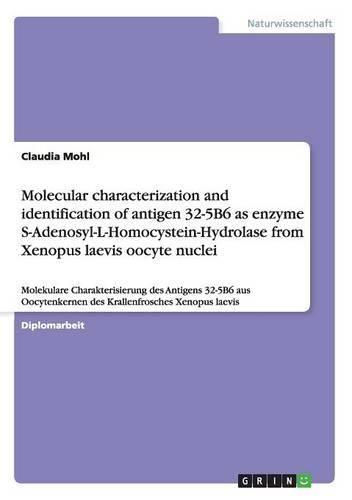Readings Newsletter
Become a Readings Member to make your shopping experience even easier.
Sign in or sign up for free!
You’re not far away from qualifying for FREE standard shipping within Australia
You’ve qualified for FREE standard shipping within Australia
The cart is loading…






Diplomarbeit aus dem Jahr 1996 im Fachbereich Biologie - Genetik / Gentechnologie, Note: keine Angabe, Eberhard-Karls-Universitat Tubingen (Max-Planck-Institut fur Entwicklungsbiologie, Tubingen), Veranstaltung: -, Sprache: Deutsch, Abstract: Molecular characterization and identification of antigen 32-5B6 as enzyme S-Adenosyl-L-Homocystein-Hydrolase from Xenopus laevis oocyte nuclei Claudia Mohl Diploma thesis in Biochemistry, Eberhard-Karls-University, Tubingen, 1996 and Max-Planck-Institut for Development Biology, Tubingen (Title and Abstract in english; Original work in german) Abstract: The aim of my diploma thesis work (1996) was molecular characterization and identification of late migrating antigen 32-5B6 on a molecular level. Antigen 32-5B6 is a protein that is distributed in cytoplasm during Blastula stage and transported into oocyte cell nuclei at Gastrula stage 12 during embryonic development of Xenopus laevis (Dreyer et al. 1982; 1983). To isolate cDNA sequences that encode the late migrating antigen 32-5B6, I screened, isolated and sequenced five cDNA clones from placques with positive antibody reaction from a Xenopus laevis ovar lambda zap II cDNA expression library. Sequence analysis showed that two cDNA clones encode the enzyme S-Adenosyl-Homocystein-L-Hydrolase (clone 10) from Xenopus laevis (Seery et al. 1994) and an isoform of this enzyme (clone 8). Molecular weight and IEP of S-Adenosyl-Homocystein-L-Hydrolase are nearly identical with those of antigen 32-5B6. To get further evidence in regard to sequence of antigen 32-5B6, proteins were isolated from original Xenopus laevis oocyte nuclei for protein microsequencing. For this reason I established a new protein purification strategy purifying proteins from original oocyte nuclei of Xenopus laevis proteom by means of anion-exchange chromatography and 2-dimensional gel electrophoresis. By means of western blot analysis I could detect two enzyme isoforms those IEPs lie in range between pH
$9.00 standard shipping within Australia
FREE standard shipping within Australia for orders over $100.00
Express & International shipping calculated at checkout
Diplomarbeit aus dem Jahr 1996 im Fachbereich Biologie - Genetik / Gentechnologie, Note: keine Angabe, Eberhard-Karls-Universitat Tubingen (Max-Planck-Institut fur Entwicklungsbiologie, Tubingen), Veranstaltung: -, Sprache: Deutsch, Abstract: Molecular characterization and identification of antigen 32-5B6 as enzyme S-Adenosyl-L-Homocystein-Hydrolase from Xenopus laevis oocyte nuclei Claudia Mohl Diploma thesis in Biochemistry, Eberhard-Karls-University, Tubingen, 1996 and Max-Planck-Institut for Development Biology, Tubingen (Title and Abstract in english; Original work in german) Abstract: The aim of my diploma thesis work (1996) was molecular characterization and identification of late migrating antigen 32-5B6 on a molecular level. Antigen 32-5B6 is a protein that is distributed in cytoplasm during Blastula stage and transported into oocyte cell nuclei at Gastrula stage 12 during embryonic development of Xenopus laevis (Dreyer et al. 1982; 1983). To isolate cDNA sequences that encode the late migrating antigen 32-5B6, I screened, isolated and sequenced five cDNA clones from placques with positive antibody reaction from a Xenopus laevis ovar lambda zap II cDNA expression library. Sequence analysis showed that two cDNA clones encode the enzyme S-Adenosyl-Homocystein-L-Hydrolase (clone 10) from Xenopus laevis (Seery et al. 1994) and an isoform of this enzyme (clone 8). Molecular weight and IEP of S-Adenosyl-Homocystein-L-Hydrolase are nearly identical with those of antigen 32-5B6. To get further evidence in regard to sequence of antigen 32-5B6, proteins were isolated from original Xenopus laevis oocyte nuclei for protein microsequencing. For this reason I established a new protein purification strategy purifying proteins from original oocyte nuclei of Xenopus laevis proteom by means of anion-exchange chromatography and 2-dimensional gel electrophoresis. By means of western blot analysis I could detect two enzyme isoforms those IEPs lie in range between pH